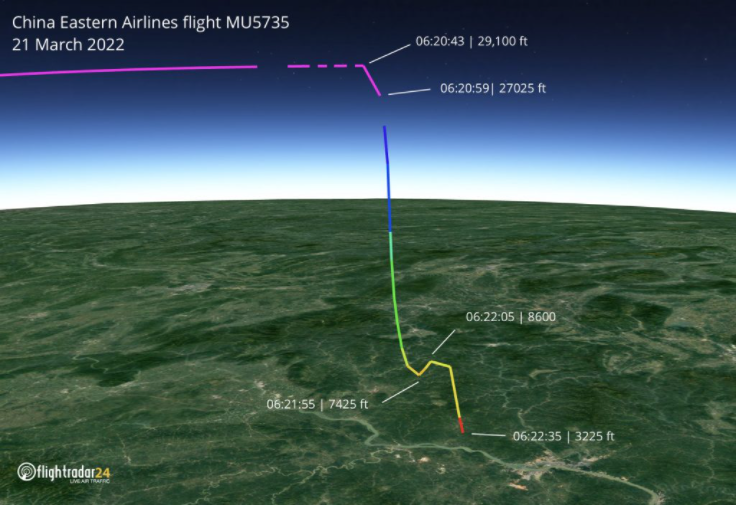Nose Dive And Silence From The Cockpit Raises Questions About China Eastern Airlines Air Crash
The Boeing 737’s rapid nose dive and lack of communication from the cockpit has raised questions about the China Eastern Airlines’ air crash that killed all 132 on board.
Ron Bartsch, managing director of Sydney-based AvLaw International Consulting and a former head of safety for Qantas Airways, tells Smart Aviation Asia Pacific that even if there was a double engine failure, pilots should still be able to put the aircraft into a gliding mode.
He says commercial aircraft, such as the Boeing 737-800, have characteristics that allow the aircraft to glide to some extent.
Bartsch cites the incident in 2009 when a US Airways Airbus A320 had a double engine failure, but the pilots were still in control and were able to have the aircraft glide and land safely in the Hudson River.
“Based on the video footage circulating online, the aircraft seems to be in a nose-dive drop. But such a vertical dive is highly unusual and unexplainable, as the aircraft would have been able to glide through the air, instead of just crashing straight down,” he says.

Picture from Straits Times is a screen capture of the video footage of the aircraft in final descent as well as a photo of the resulting fire on the ground.
The 737-800, local registration B-1791, crashed on 21 March in southwest China’s Guangxi province with 123 passengers and nine crew on board. There were no survivors from the crash in which the aircraft nose-dived at high-speed and impacted the ground with strong force.
Pictures from the crash site show that the aircraft shattered into small pieces upon impact. The aircraft crashed at approximately 14:22hr local time when weather conditions were reported to be benign.
The aircraft’s flight profile, as captured by Flightradar24, shows the 737-800 was cruising at 29,100ft at 14:20hr when it started its rapid descent. At 14:21hr, it was at 7,425ft and then climbed 1,175ft to 8,600ft before going into its final rapid descent. At 14:22hr it was too low to be detected by radar and crashed into the ground.

Picture from Flightradar24 shows the aircraft’s flight profile in UTC time
Video footage, captured from a surveillance camera on the ground, shows the aircraft apparently intact in its final descent.
Bartsch says the fact the aircraft was able to pull out of its nose dive at 7,425ft and climb 1,175ft to 8,600ft indicates that someone in the cockpit briefly regained control of the aircraft and tried to avert a crash.
Curious Case Of No Communication
Bartsch also says the fact that there was no mayday call is puzzling.
The Civil Aviation Administration of China (CAAC) says during the rapid descent, there was no mayday call from the aircraft and no response from the pilots despite repeated calls by Guangzhou air traffic control.
Bartsch says to do a mayday call does not take much time and something a pilot would do. “In the scenario of mechanical issues, the pilots should still be able to get a mayday call out, but the lack of it in this incident is puzzling,” he adds.
The aircraft began its rapid descent soon after it entered the Guangzhou flight information region (FIR).
Bartsch says pilots, as part of standard procedure, are supposed to make radio contact with the relevant air traffic control (ATC) when they entire a FIR. But there have been no news reports from China mentioning whether this occurred. Instead, the reports have highlighted there was no response from the aircraft when contacted repeatedly by Guangzhou ATC as the aircraft was its rapid descent.
Some news reports have suggested that icing problems could have caused the aircraft to crash, but Bartsch says the 737-800’s sensors on board are able to detect icing and that the 737-800 is equipped with deicing equipment.
Three Pilots On Board
A China Eastern Airlines official tells the media there were three pilots on board, one pilot more than required, and that all three were all in good health.
“The captain was hired in January 2018 and had 6,709 hours of total flying experience, while the first and second officers had 31,769 hours and 556 hours, respectively,” the official adds.
“From what we know, the performance of the three pilots had been good and their family life relatively harmonious,” the official says.
While the names of the pilots remain undisclosed, media reports say the first officer is considered a veteran because of their more than 30,000 hours of flying experience.
One Black Box Found
CAAC says the cockpit voice recorder (CVR) has been found.
Zhu Tao, a CAAC official, says the data storage units in the CVR are relatively complete despite some damage, and that it has been sent to Beijing.
Authorities are still searching for the flight data recorder (FDR).
The FDR and CVR are designed to be crash proof and almost indestructible, says the CAAC.
Feature from, from Tweaktown.com, shows the crash site.

